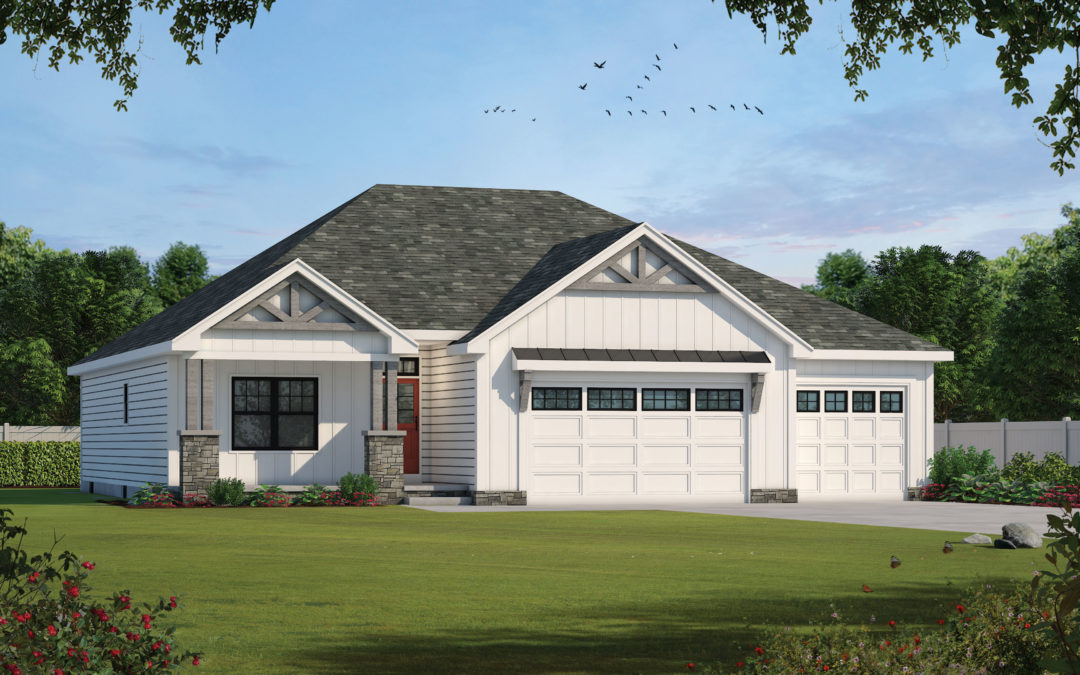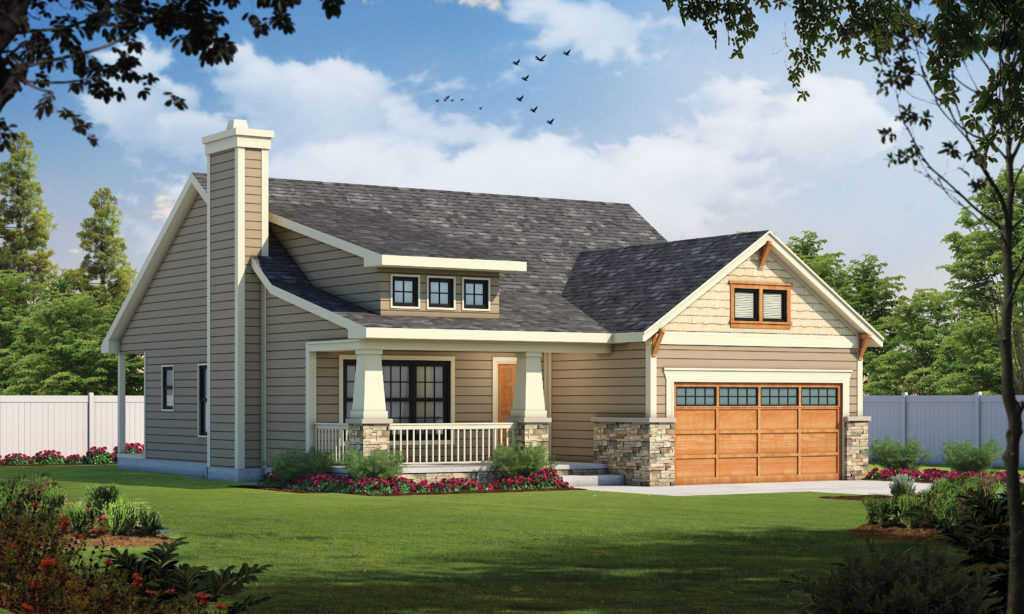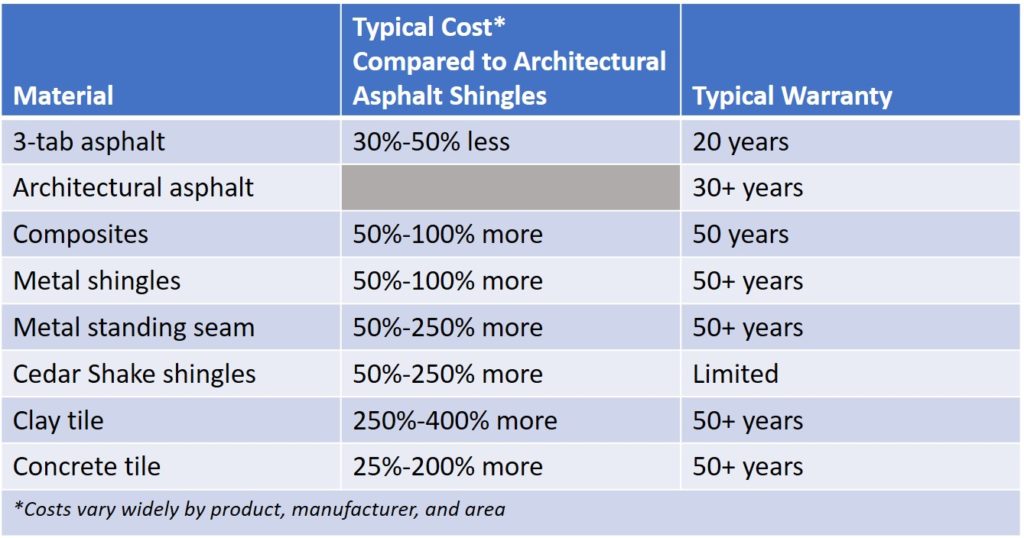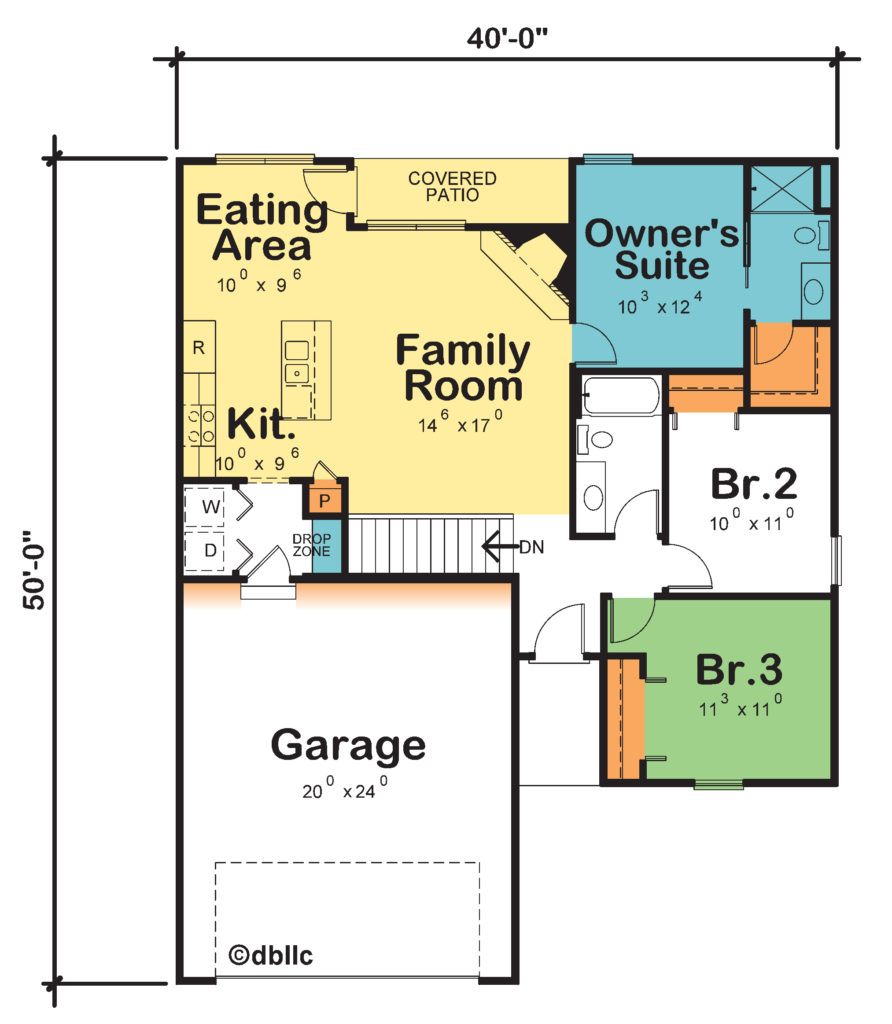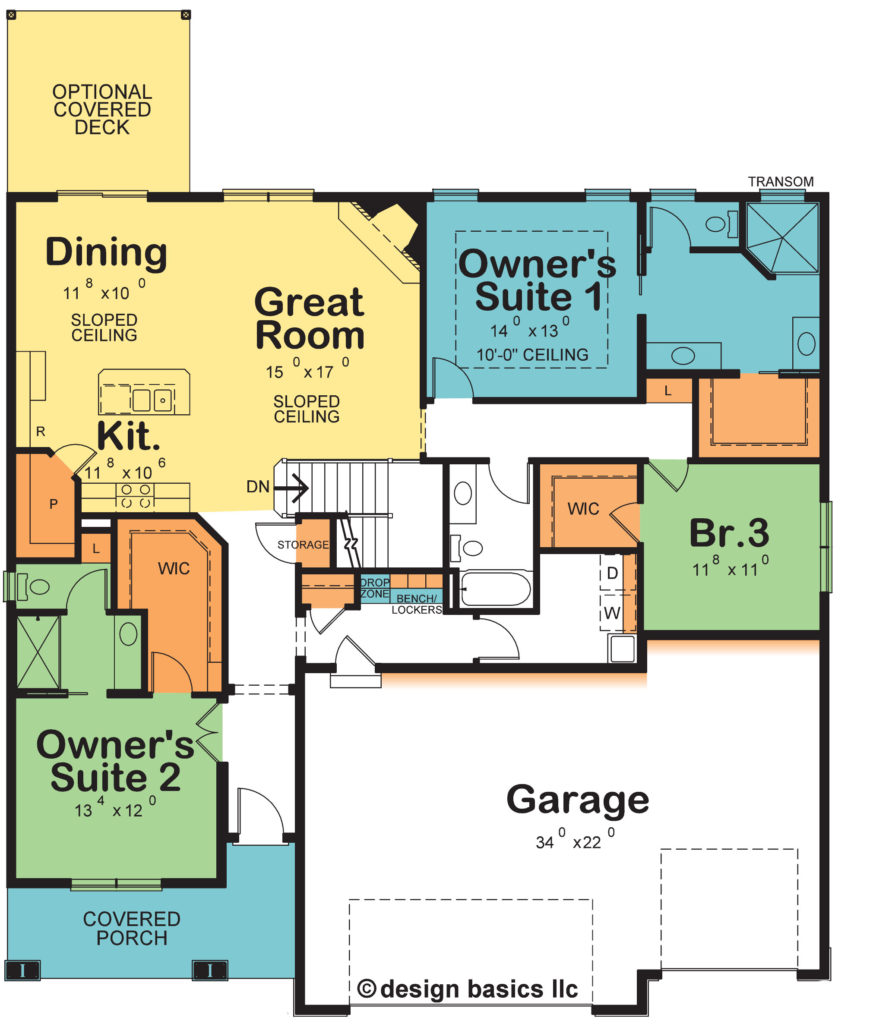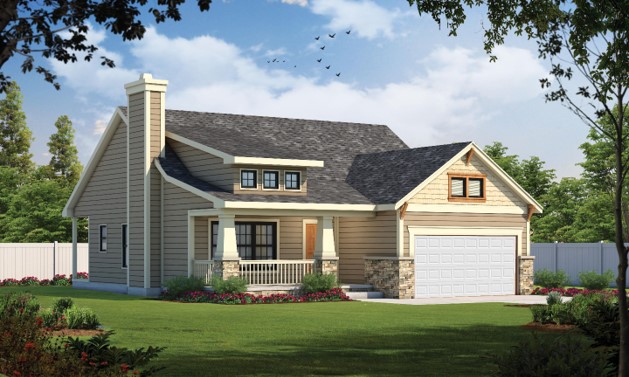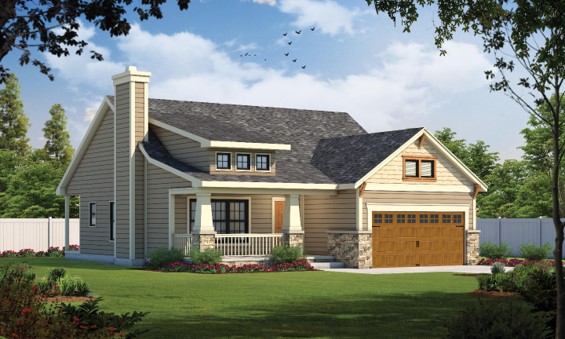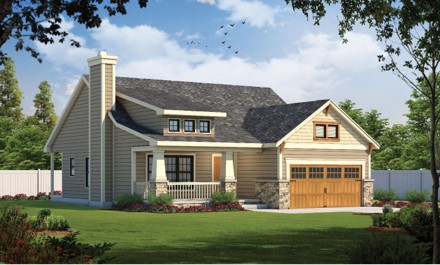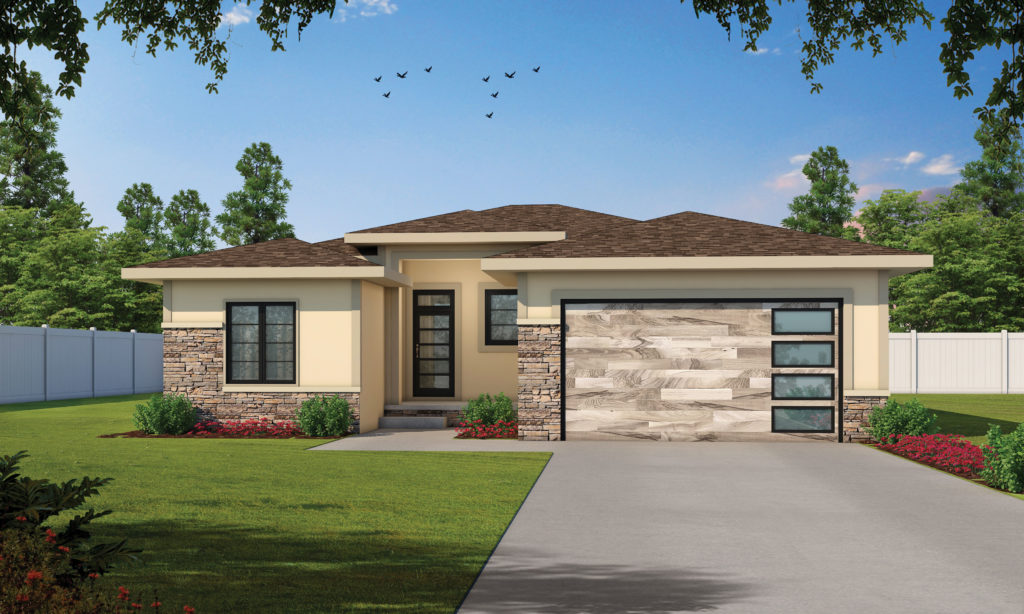How your choices affect the cost of your new home.
What’s a “brake light home”? One that is so stunning, that brake lights come on as people slow down to take in its beauty while driving by! New homes of almost any size, at almost any price point, can exude curb appeal. But curb appeal has a price tag. While your home’s exterior design and style will, in large part, dictate costs, there are still many choices you can make that will significantly affect your home’s attractiveness and cost.
The Kendrick (#8532) plan is less than 1,200 square feet, yet is a definite “Brake Light” home!
Your choice of roofing can have a sizable impact on your home’s price and appearance. More than two out of three homes get topped off with asphalt shingles, which also tend to be among the most competitively priced options. Typically backed by a 20-year warranty, three-tab shingles are the thinnest and least expensive. Adding dimension and shadow lines, architectural asphalt shingles are thicker, heavier, more expensive, and often backed by 30-year and even longer warranties. Depending on where you live, spending a little more for hail impact-resistant and/or high wind-rated shingles may reduce your homeowner’s insurance premiums more than their incremental increase to your mortgage payment, reducing your actual monthly housing cost. Also, keep in mind that light-colored shingles reflect sunlight, helping lower utility bills in hot climates, while dark shingles absorb sunlight, keeping homes warmer and reducing heating costs in colder climates.
Residential metal roofing has been growing steadily in popularity. Steel and aluminum are the most common metals used, though copper has long been a popular accent metal roof product. Metal roofing prices start competitively with higher-end architectural asphalt shingles. You can expect metal roofing to last 50 years or longer, and many metal roofing products qualify for insurance discounts. Standing seam metal roofing has visible vertical “ribs,” and newer metal roofing profiles simulate wood shakes, shingles, tile, and slate. One reported downside is that metal roofing can be noisier in rain and hailstorms.
In spite of their distinctive good looks, cedar shakes have fallen out of favor due to their higher initial cost and high ongoing homeowner’s insurance expense. Slate is sometimes still used in the northeast; clay or cement tiles predominately appear on roofs in the southwest and Florida, a natural complement to Mediterranean exterior styling. In addition to being more expensive roofing material, slate and tile are heavier, requiring additional roof engineering and framing expense.
Man-made composite shingles have largely replaced wood shakes and slate roofing. Often considered a green building product due to using recycled content, composite shingles look strikingly similar to their natural counterparts but are much lighter, backed by long warranties, and very durable – with some carrying those insurance discount opportunities for high wind and hail impact ratings.
Your siding options, like roofing, also have considerable impact on your home’s appearance and cost. Vinyl is the most widely used siding material due to its relatively low-maintenance (no painting required!) and generally being the lowest cost. Thickness of the siding and the presence of insulated backing are primary cost factors. Engineered wood (e.g., LP® SmartSide®) and fiber-cement (e.g., James Hardie HardiePlank®) prices start comparable with high-end vinyl siding. Both options are very durable, with HardiePlank carrying a non-pro-rated 30-year warranty, while SmartSide’s 50-year warranty is pro-rated after 5 years. As with natural wood siding, which tends to be slightly more expensive than engineered wood, re-painting every 5-10 years adds to the cost of ownership, but also allows you (or the next owner) to change your home’s color. Note: siding profiles other than the traditional horizontal look, such as shakes, board and batten, etc., will add cost. Typically, higher than wood siding, masonry products tend to be relatively close to each other in pricing, with stucco (natural or EIFS) a little less than brick; and brick a little less than faux stone (e.g., cultured stone). Real stone, however, can be two to three times more expensive. Due to the added costs, masonry finishes are often used as accents and focal points, rather than completely covering your home’s exterior. Masonry products not only look great, they require little upkeep and are extremely durable, helping you avoid future replacement costs.
Windows can have a sizable impact on your home’s price, but you may not “see” the difference. We’ll limit this topic to standard windows as specialty windows run the gamut of pricing. Beyond the number and size of windows, major factors include the type (e.g., single hung, double-hung, sliding, casement); frame material (e.g., vinyl, wood, clad); window performance, options such as grids between the glass panes; and of course, brand.
Type. Single-hung windows are typically the least expensive, having a stationary upper, while the lower sash raises and often tilts in for cleaning. Based on retail pricing for egress windows from a well-known brand, next on the price ladder are casement windows (25%-40% higher than single-hung), which are hinged on one side and crank outwards; sliding windows (60%-90% higher than single-hung), having one sash which slides horizontally; and double-hung windows (roughly twice the price of single hung) in which both the upper and lower sashes raise, lower, and tilt-in.
Frame Material. Vinyl windows are usually the least costly as well as being low maintenance. Expect to spend 15%-30% more for fiberglass, around 50%-75% more for wood, and 75%-200% more for clad and composite windows. Keep in mind, these price differences are for the windows only, not including installation.
Even for a modest home like the Krebs Pointe (#42395), the window frame material makes a big difference in price. Using retail pricing for the egress windows from a well-known national brand, the vinyl double-hung window package cost is $1,880, while the aluminum-clad/wood interior window package priced out at $5,176.
Window Performance. With new homes being built to more stringent energy codes today, most windows are going to be double-panes of glass, and many are built with low-e coatings on the glass and may be filled with a gas such as Argon between the panes. For additional energy savings, some windows have three panes of glass. Also, some windows are impact resistant for protection against flying debris, and/or built to withstand very high wind pressures – all of which add to the window’s cost.
Options. Nearly invisible window screens, varying grille styles, upgraded hardware, and an emerging array of technology options can add to your home’s beauty and enjoyment. And cost. One design option you may have is to join (“mull”) two windows together to make a single double-wide window. This provides the same amount of daylight as having the individual windows but reduces installation costs.
Providing room for a bed headboard, the Cedar Hill’s (#42435) Bedroom Suite 1 splits its windows. With two holes to cut in the wall and two separate windows to trim out, those split windows will be more expensive than the same size windows that have been mulled together as in Bedroom Suite 2.
Brands. Quality… research and development… service… warranty… style… options… years in business… leading window brands became leading window brands for a reason. Sure, performance ratings as provided on the stickers adhered to new windows are one basis for making your decision. But what is the value of knowing when you have an issue with your home’s windows that it will be taken care of, versus saving a few dollars up front and gambling that a new window brand will be there for you 10 years from now? Resale should be kept in mind as well, as highly regarded window brands are one of the surest ways to communicate yours is a quality home, potentially enhancing both the home’s value and leading to a quicker sale.
Garage Doors. The humble garage door. It goes up and down and keeps your golf clubs from getting stolen. But one of your home’s focal points? If your garage doors face the street, did you realize those doors are probably the single largest architectural element on the front of your home? Everybody’s home doesn’t look alike, yet when you drive down many streets, everybody has essentially the same garage door style – often the raised 32-panel door. Because of their size, and because they are sometimes the closest part of your home to the street, garage doors style should not be overlooked.
Size, insulation, and warranty are reflected in garage door prices. But the material they are made of, style, and brand likely have the most significant impact on price.
Good, better, best? Garage door manufacturer Clopay® offers an online Door Imagination System™ that is a great way to visualize how your home would look with different garage door styles and materials. Using their tool and the rendering of Design Basics’ Kendrick (#8532) home plan, shown at left is the lower-priced Classic™ Steel raised 32-panel insulated door; at right, a stunning wood door from the Reserve® Wood Semi-Custom line; and, balancing cost and aesthetics, in the center, a wood-look insulated door from the company’s Gallery® Steel series. (Click on images to enlarge.)
Entry Door Systems. Did you know that stylish entry doors could increase a home’s perceived value by an average of 4.2% or $18,750? That’s what a study by one of the leading door manufacturers, Therma-Tru, found. Akin to garage doors, too often a home’s front entry door was the “default” selection – the good old Colonial 6-panel door, or whatever is the builder’s standard front door.
Material composition, glass options, and style are large influencers of entry door system prices. Insulated steel doors tend to be the least expensive, followed by increasingly popular fiberglass doors, and at the pricier end of the spectrum, wood doors. For aesthetics and security (we like to see who is at the front door), entry doors will either have glass in the door, sidelites, or both. The presence of sidelites may be limited by the width of your home’s front entry design. For an even brighter entryway, there may be a transom window atop the entry door. All of these glass options add to the cost.
It would almost be a crime to install a standard 6-panel entry door if you were building the Kinney Haven (#42461) design. Both your personal style and your home’s exterior style should be reflected in that door! Modern? French Country? Craftsman? Does the door you chose look “right”? As guests arrive, your home’s front door can make a big impression. This can be money well spent; you enjoy the stylish door, and as the Therma-Tru study reported, you may recoup the added investment (or more!) at resale.
While your home’s exterior design is the primary cost driver, as you have seen, roofing, siding, window, and door choices can affect your new home’s price by tens of thousands of dollars. Most of us have budget restrictions when building a new home, or at least a price we are comfortable with. So, it becomes a balancing act, usually requiring tradeoffs to meet your budget and vision for your new home. Similarly, product choices inside the home have a surprising impact on your new home’s cost, which we look at next time.
For more resources on thoughtful design and products:
- View other articles on our blog
- Browse our Her Home™ Magazine
- Thoughtful Design Concepts
Cover Image: Cedar Hill (#42435)
